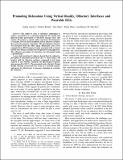Promoting relaxation using virtual reality, olfactory interfaces and wearable EEG
Author(s)
Amores Fernandez, Judith; Richer, Robert; Zhao, Nan; Maes, Patricia; Eskofier, Bjoern M.
DownloadPromoting_Relaxation_by_Using_Virtual_Reality__Olfactory_Interfaces_and_Wearable_EEG.pdf (5.678Mb)
Open Access Policy
Open Access Policy
Creative Commons Attribution-Noncommercial-Share Alike
Terms of use
Metadata
Show full item recordAbstract
The ability to relax is sometimes challenging to achieve, nevertheless it is extremely important for mental and physical health, particularly to effectively manage stress and anxiety. We propose a virtual reality experience that integrates a wearable, low-cost EEG headband and an olfactory necklace that passively promotes relaxation. The physiological response was measured from the EEG signal. Relaxation scores were computed from EEG frequency bands associated with a relaxed mental state using an entropy-based signal processing approach. The subjective perception of relaxation was determined using a questionnaire. A user study involving 12 subjects showed that the subjective perception of relaxation increased by 26.1 % when using a VR headset with the olfactory necklace, compared to not being exposed to any stimulus. Similarly, the physiological response also increased by 25.0 %. The presented work is the first Virtual Reality Therapy system that uses scent in a wearable manner and proves its effectiveness to increase relaxation in everyday life situations.
Date issued
2018-04Department
Massachusetts Institute of Technology. Media LaboratoryJournal
15th International Conference on Wearable and Implantable Body Sensor Networks (BSN)
Publisher
Institute of Electrical and Electronics Engineers (IEEE)
Citation
Amores, Judith et al. "Promoting relaxation using virtual reality, olfactory interfaces and wearable EEG." 15th International Conference on Wearable and Implantable Body Sensor Networks (BSN), March 2018, Las Vegas, NV, USA, Institute of Electrical and Electronics Engineers, April 2018 © 2018 IEEE
Version: Author's final manuscript
ISBN
9781538611098
ISSN
2376-8894